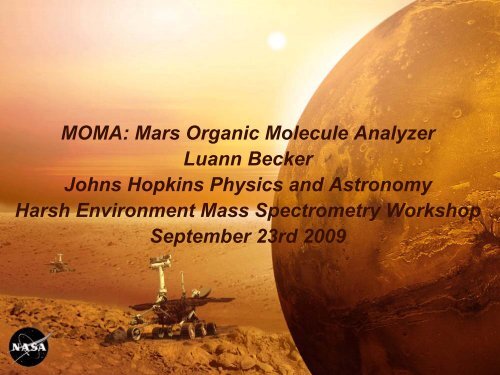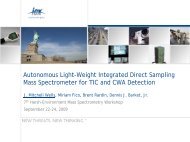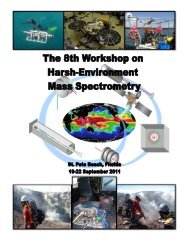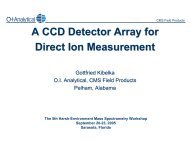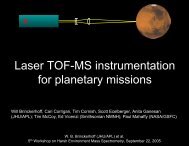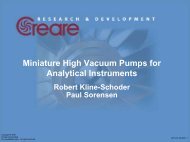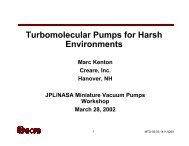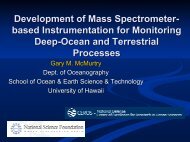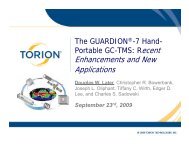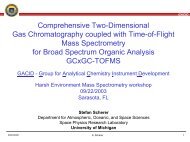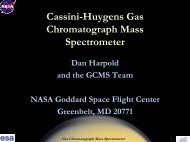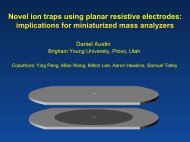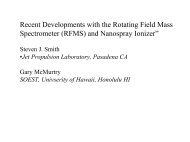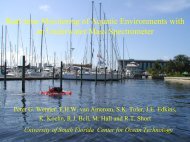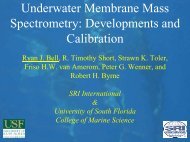Mars Organic Molecule Analyzer (MOMA) - Harsh-Environment ...
Mars Organic Molecule Analyzer (MOMA) - Harsh-Environment ...
Mars Organic Molecule Analyzer (MOMA) - Harsh-Environment ...
You also want an ePaper? Increase the reach of your titles
YUMPU automatically turns print PDFs into web optimized ePapers that Google loves.
<strong>MOMA</strong>: <strong>Mars</strong> <strong>Organic</strong> <strong>Molecule</strong> <strong>Analyzer</strong><br />
Luann Becker<br />
Johns Hopkins Physics and Astronomy<br />
<strong>Harsh</strong> <strong>Environment</strong> Mass Spectrometry Workshop<br />
September 23rd 2009
Strategy for Future Missions to <strong>Mars</strong><br />
- Lessons learned from ‘Past’<br />
Rover/Lander Missions: Emphasis<br />
on Life Detection<br />
- ‘Present’ Missions: Looking Ahead to<br />
the Next Decade<br />
- New Instrument Concepts in Search<br />
for Life: <strong>MOMA</strong><br />
2
Mission Timeline<br />
MSL<br />
Lander<br />
Discovery<br />
Mid Rover<br />
Mission<br />
NASA<br />
Joint Missions<br />
NASA/ESA<br />
Exo<strong>Mars</strong><br />
3
Earth and <strong>Mars</strong> Today<br />
4
Map of <strong>Mars</strong> showing H 2 O and Landing Sites<br />
P<br />
5
Previous Mass Spectrometry Concepts<br />
• High mass range à complex organic analysis<br />
• Drill to 2m; depth profiling<br />
• Multiple sampling modes<br />
6
Viking Missions: What Happened?<br />
Viking (1976)<br />
– GCMS: Surface soil<br />
– No organics found by<br />
GCMS<br />
– Nutrient Experiment<br />
Inconclusive<br />
Conclusions:<br />
Highly oxidizing soil, low pH<br />
(acidic), ionizing radiation<br />
produce non-volatile organic<br />
salts resulting in more<br />
refractory ‘labile’ organic<br />
material<br />
1 Benner et al., (2000) The Missing <strong>Organic</strong> <strong>Molecule</strong>s on <strong>Mars</strong>? PNAS 2425-2430.<br />
2 Kminek G and Bada JL (2006). The effect of ionizing radiation on the preservation of amino acids on <strong>Mars</strong>. Earth Planet. Sci. Lett., 245, 1−5.<br />
1<br />
2<br />
7
<strong>Organic</strong>s in Murchison Meteorite<br />
Murchison Meteorite LDMS-TOF<br />
242 252 278<br />
228<br />
300<br />
178 202<br />
314<br />
328<br />
342<br />
Murchison ‘Kerogen’<br />
Pendleton & Allamandola,<br />
Ap. J. Sup. Ser. 138, 75 (2002)<br />
8
Is there, or was there, life on <strong>Mars</strong>?<br />
• ALH84001<br />
– Martian meteorite<br />
– Antarctica<br />
– 1996: nanobacteria<br />
fossils; amino acids,<br />
PAHs found<br />
1 Becker, L., Popp, B., Rust, T., Bada, EPSL., 167, 71-79 (1999); Becker, L. NRC Signs of Life Workshop, 161-173 (2000) .<br />
2 Becker, L., Popp, B., Rust, T., Bada, J. Adv. Space Res., 24, 4, 477 (1999).<br />
9
What is <strong>MOMA</strong>?<br />
• AP MALDI = Atmospheric Pressure Matrix Assisted Laser<br />
Desorption/Ionization (ASTEP)<br />
– a pulsed laser is focused onto a solid sample in ambient environment<br />
(<strong>Mars</strong> P = 5-10 Torr CO 2<br />
; IR or UV laser Nd:YAG 266 nm)<br />
– neutral and ionized molecules are produced<br />
– molecules are drawn into a mass spectrometer for analysis<br />
• ITMS = Ion Trap Mass Spectrometer<br />
– ions are stored in stable orbits by a 3D quadrupolar RF electric field in<br />
the presence of a rarified background gas (1-10 mTorr CO 2<br />
works fine)<br />
– ions are scanned out and detected by ramping the RF amplitude<br />
– can be used to isolate individual ions for fragment analysis (MS/MS)<br />
* The AP-MALDI was merged with a GCMS proposed by a German and<br />
French team for the Exo<strong>Mars</strong> mission; It is part of the <strong>MOMA</strong> suite<br />
which also includes Pyr-GC-EI-MS<br />
10
<strong>MOMA</strong> Science Requirements<br />
What are our requirements?<br />
1. the mass analyzer will need to be compatible with both<br />
laser desorption and GCMS<br />
2. laser desorption will be carried out in situ, on solid<br />
samples presented at <strong>Mars</strong> atmospheric pressure<br />
3. the mass range should encompass that expected for<br />
establishing the existence of organic or potentially<br />
biological relevant molecules (e.g. small peptides), ca<br />
2,000 Da<br />
4. the instrument will need to accommodate two ionization<br />
sources (LD and electron ionization)<br />
11
Why use an ion trap?<br />
ION Trap Selection<br />
1. most compatible with external (atmospheric) ionization<br />
using laser desorption<br />
a. TOFs (and others) require very high vacuum and a<br />
means for sample introduction<br />
b. orthogonal TOFs can be used with external ionization<br />
but require very high pumping speed to achieve high<br />
vacuum<br />
2. has the possibility for doing MS/MS for structural<br />
analysis<br />
3. low power ion traps have been used successfully in<br />
GCMS configurations<br />
12
<strong>MOMA</strong> Instrument Concept Design<br />
What are the specific challenges?<br />
1. combining low voltage/low power with a<br />
sufficiently high mass range<br />
2. transferring ions formed in the <strong>Mars</strong><br />
environment into the vacuum chamber and<br />
the ion trap<br />
3. accommodating two sources of ions: those<br />
generated externally by LD and those<br />
generated by the GC either internally or<br />
externally using electron ionization<br />
13
<strong>MOMA</strong> LDMS Instrument Concept Design<br />
Atmospheric pressure<br />
laser desorption on<br />
Earth<br />
Pulsed UV laser<br />
P=760 torr<br />
Extended capillary<br />
Atmospheric pressure<br />
laser desorption on<br />
<strong>Mars</strong><br />
Quadrupole, hexapole or octopole<br />
ion guides<br />
P=5-10 torr<br />
Orifice<br />
14
<strong>MOMA</strong> Instrument Concept Design<br />
Accommodating low power/low voltage and high mass range<br />
TABLE I. Quadrupole and Cylindrical Ion Trap Parameters<br />
Param eter Finnigan Cooks Rosetta Cylindrical <strong>Mars</strong><br />
1<br />
Fundamental _ /2¹ (MHz) 1.1 1.1 0.6 1.1 1.0 0.8<br />
Maximum amplitude V max (0-p) 7.5 kV 7.5 300 V 7.5 kV 300 V 300 V<br />
kV<br />
Radius r 0 (cm) 1.0 0.5 0.8 1.0 0.5 0.5<br />
Axis 2z 0 (cm) 1.0 0.5 1.13 1.79 0.5 0.5<br />
Mass range (Da) in mass -selective instability 650 2,600 150 600 126 197<br />
mode q eject = 0.908<br />
Supplemental RF frequency (kHz) 69.9 NA NA 425 22.1 34.4<br />
qeject 0.182 NA NA NA 0.057 0.089<br />
Mass range (Da) in resonance ejection mode 3,250 NA NA NA 2,000 2,000<br />
<strong>Mars</strong><br />
2<br />
( m / z)<br />
max<br />
=<br />
q<br />
8V<br />
max<br />
2 2<br />
( r 2z<br />
)<br />
2<br />
eject<br />
Ω<br />
0<br />
+<br />
0<br />
a<br />
Kaiser RE, Jr., Cooks RG, Moss J, Hemberger<br />
PH, Mass Range Extension in a Quadrupole<br />
Ion-trap Mass Spectrometer, Rapid Commun.<br />
Mass Spectrom. 3, (1989) 50-53<br />
b<br />
March RE, Todd JF, Quadrupole Ion Trap Mass<br />
Spectrometry, John Wiley & Sons, Inc. Hoboken<br />
NJ, 2005<br />
15
Uniqueness of <strong>MOMA</strong> Design<br />
What are the specific innovations?<br />
1. combining low voltage/low power and a mass range up<br />
to 2,000 Da using lower trap frequency and a<br />
supplemental excitation with very low q eject value<br />
2. accommodating LD and EI using internal electron<br />
ionization with the electron source on the ring electrode<br />
3. supplemental voltage frequency scanning of the mass<br />
range<br />
4. use of CO 2 as a bath gas in the LD mode<br />
16
<strong>MOMA</strong> Prototype Design Concept<br />
Low voltage/low power and high mass range using lower trap<br />
frequency and supplemental excitation at very low q eject value<br />
<strong>MOMA</strong> Ion Trap Parameters:<br />
Fundamental _ /2¹<br />
Maximum amplitude V<br />
max<br />
(0-p)<br />
Radius r 0<br />
Axis 2z 0<br />
Mass range in mass-selective instability mode q eject<br />
= 0.908<br />
800 kHz<br />
300 V<br />
<strong>Mars</strong> 2<br />
0.5 cm<br />
0.5 cm<br />
197 Da<br />
Supplemental RF frequency<br />
34.4 kHz<br />
Supplemental RF voltage (axial modulation)<br />
5-10 V<br />
q eject<br />
0.089<br />
Mass range in resonance ejection mode<br />
2,000 Da<br />
Bath gas He or CO<br />
2<br />
Ionization:<br />
Ion introduction:<br />
laser desorption at <strong>Mars</strong> atmosphere (5 -10 Torr)<br />
RF quadrupole ion guide<br />
17
<strong>MOMA</strong> Instrument Concept<br />
A novel internal EI<br />
source with filament<br />
mounted on the ring<br />
electrode<br />
Ions from laser<br />
desorption/ionization<br />
at <strong>Mars</strong> atmosphere<br />
(5-10 Torr)<br />
Internal EI for GCMS<br />
+<br />
- -<br />
+<br />
Filament<br />
supply<br />
Electron<br />
energy<br />
Fundamental RF<br />
voltage generator<br />
800 kHz, 300-<br />
700V 0-p<br />
Supplemental<br />
RF generator<br />
18
<strong>MOMA</strong> <strong>Mars</strong> <strong>Organic</strong> <strong>Molecule</strong> <strong>Analyzer</strong><br />
Protoype built by SESI<br />
19
<strong>MOMA</strong> ITMS Operational Requirements<br />
<strong>MOMA</strong> ITMS must be capable of:<br />
1) Operating with CO 2<br />
as a bath gas<br />
2) Unit Mass Resolution<br />
3) MS/MS capability<br />
556.6<br />
Leucine Enkephalin<br />
MW 556.6<br />
MH<br />
YGGFL<br />
Y=Tyr, G=Gly<br />
F= Phe, L=Leu MS/MS<br />
a 4<br />
MH-H 2<br />
0<br />
530 540 550 560 570 580 590<br />
m/z<br />
CO 2 pressure<br />
Peak width<br />
1.2 x 10 -4 Torr 0.5 Da<br />
10 -3 Torr 1.5 Da<br />
100 200 300 400 500 600 700<br />
m/z<br />
V. Doroshenko, SESI<br />
20
Leu-enkephalin<br />
(YGGFL), m/z =<br />
556.6<br />
Bradykinin<br />
fragment1-7<br />
(RPPGFSP)<br />
m/z = 757.4<br />
Angiotensin II<br />
(human) (DRVYI),<br />
m/z = 1046.5<br />
P 14<br />
R<br />
(polyproline)<br />
(PPPPPPPPP<br />
PPPPPR) m/z<br />
= 1534<br />
<strong>MOMA</strong> Prototype-1<br />
4 peptide mixture; original<br />
or ‘raw’ data<br />
experimental conditions: V RF<br />
= 700 V 0‐p<br />
;<br />
P = 0.7 mTorr (CO 2<br />
) in the trap<br />
Leu-enkephalin<br />
(YGGFL), m/z =<br />
556.6<br />
Bradykinin<br />
fragment1-7<br />
(RPPGFSP)<br />
m/z = 757.4<br />
P 14<br />
R (polyproline)<br />
(PPPPPPPPPPPPPPR<br />
) m/z = 1534<br />
4 peptide mixture;<br />
300 points smoothing<br />
Angiotensin II<br />
(human)<br />
(DRVYI), m/z =<br />
1046.5<br />
experimental conditions: V RF<br />
= 700 V 0‐p<br />
;<br />
P = 0.7 mTorr (CO 2<br />
) in the trap<br />
600 800 1000 1200 1400 1600<br />
21
MS/MS <strong>MOMA</strong> Prototype‐1<br />
2.0<br />
1.5<br />
P 14 R (polyproline)<br />
Intensity<br />
1.0<br />
2P<br />
(PPPPPPPPPPPPPPR)<br />
m/z = 1534<br />
experimental conditions: trap<br />
RF 700 V 0‐p<br />
0.7 mTorr CO 2<br />
in<br />
the trap<br />
0.5<br />
2P<br />
2P<br />
P<br />
2P<br />
P<br />
2P<br />
P<br />
2P<br />
P<br />
0.0<br />
400 600 800 1000 1200 1400 1600 1800 2000<br />
m/z<br />
22
<strong>MOMA</strong> GCMS Interface<br />
Count<br />
3000<br />
2000<br />
1000<br />
0<br />
1500<br />
1000<br />
500<br />
0<br />
INTERNAL IONIZATION w/ CO 2<br />
237.5V, -60/+240V pulsing<br />
EXTERNAL IONIZATION w/ CO 2<br />
0 100 200 300 400 500 600 700 800<br />
Mass<br />
166.5V<br />
237.5V<br />
166.25V,<br />
1200<br />
1000<br />
800<br />
600<br />
400<br />
200<br />
0<br />
-60/+160V pulsing<br />
JHU SOM<br />
CO 2 as the bath gas<br />
T. Evans-Nguyen<br />
23
Gold Standard LD Ion Trap Mass Spectrometer<br />
Thermo LD ITMS SESI Peru Desert<br />
JHU PHA Gold Standard<br />
336<br />
644<br />
834<br />
1080<br />
1250<br />
1476<br />
172<br />
1665<br />
1891<br />
Jarosite<br />
24
In Martian Analog Samples<br />
KT boundary extra by CH3OH in He266nm_40 #1-88 RT: 0.00-1.99 AV: 88 NL: 5.92E-1<br />
T: ITMS + p MALDI Full ms [100.00-1000.00]<br />
262.25<br />
100<br />
256<br />
266<br />
95<br />
246.17<br />
90<br />
256<br />
85<br />
80<br />
242<br />
75<br />
356.08<br />
70<br />
65<br />
276<br />
232.25<br />
60<br />
228<br />
302 270<br />
55<br />
288<br />
50<br />
274.25 370.17<br />
288.25<br />
45<br />
326.25<br />
224.17<br />
RelativeAbundance<br />
302.25<br />
40<br />
384.17<br />
KT boundary Magic Layer<br />
65 myr Extinction Event<br />
35<br />
30<br />
25<br />
20<br />
15<br />
10<br />
5<br />
398.33<br />
202<br />
412.25<br />
452.17<br />
428.17<br />
464.25<br />
178<br />
470.25<br />
210.08<br />
628.17<br />
504.25<br />
606.00<br />
588.33<br />
662.33 710.33<br />
518.25 730.42<br />
198.25 540.42<br />
776.50<br />
648.42 704.50<br />
899.08<br />
581.17 834.75 760.50 854.75<br />
782.33 813.42<br />
870.33 907.42<br />
911.50 949.58<br />
135.17 188.33<br />
993.67<br />
106.83 177.92<br />
396 452 500 600 700<br />
0<br />
100 150 200 250 300 350 400 450 500 550 600 650 700 750 800 850 900 950 1000<br />
scan T extr by tolu in He 266nm_090724135822 #1-45 RT: 0.00-2.68 AV: 45 NL: 3.03<br />
: ITMS + p MALDI Full ms [150.00-2000.00]<br />
276.17<br />
100<br />
278<br />
95<br />
90<br />
85<br />
RelativeAbundance<br />
80<br />
75<br />
70<br />
65<br />
60<br />
55<br />
50<br />
45<br />
40<br />
35<br />
30<br />
25<br />
20<br />
15<br />
202<br />
202.17<br />
252<br />
228<br />
216.17<br />
230.17<br />
252.17<br />
266.17<br />
300<br />
290.17<br />
300.17<br />
318.25<br />
326.17<br />
350<br />
350.17<br />
374.17<br />
400<br />
m/z<br />
Escanaba Trough Hydrothermal Vent<br />
East Pacific Rise<br />
10<br />
340.17<br />
364.25<br />
5<br />
392.25 424.08<br />
723.50<br />
448.25 682.33<br />
668.08 699.42<br />
625.33<br />
487.00 639.33 766.08<br />
590.42<br />
470.17 741.50 777.50<br />
515.17 557.17<br />
192.17 575.25<br />
178.08<br />
0<br />
150 200 250 300 350 400 450 500 550 600 650 700 750 800<br />
m/z
PEG 600 with He and CO 2<br />
P E G 6 0 0 w i th H e tu rb o # 1-102 R T : 0.00-2.00 AV: 102 N L : 3.04<br />
T: ITM S + p M ALD I t Full m s [100.00-2000.00]<br />
100<br />
95<br />
789.33<br />
90<br />
701.33<br />
85<br />
80<br />
75<br />
657.33<br />
70<br />
65<br />
60<br />
613.33<br />
833.33<br />
Peg 600 He<br />
55<br />
50<br />
45<br />
877.33<br />
40<br />
569.00<br />
906.00<br />
35<br />
30<br />
921.33<br />
950.00<br />
550.67 994.00<br />
25<br />
379.00<br />
20<br />
1038.00<br />
1139.33<br />
1183.33<br />
15<br />
10<br />
5<br />
190.00<br />
503.00 1227.00<br />
278.00 481.00<br />
1248.67<br />
1365.33<br />
256.00 335.00<br />
459.00<br />
1408.67<br />
411.33 1466.33<br />
172.00<br />
1584.00<br />
234.00 1626.33<br />
133.00 1758.67<br />
1834.00 1947.67<br />
0<br />
100 200 300 400 500 600 700 800 900 1000 1100 1200 1300 1400 1500 1600 1700 1800 1900 2000<br />
m /z<br />
PEG 600 + C H C A w ith C 02 turbo_090625110557 # 1-45 R T : 0.00-0.87 AV: 45 N L : 3.28<br />
T: ITM S + p M ALD I t Full m s [150.00-2000.00]<br />
100<br />
95<br />
849.33<br />
937.00<br />
90<br />
808.00<br />
85<br />
80<br />
979.33<br />
75<br />
739.67<br />
70<br />
65<br />
651.67<br />
709.33<br />
1023.67<br />
Peg 600 CO 2<br />
60<br />
55<br />
1066.67<br />
50<br />
45<br />
40<br />
564.00<br />
622.67<br />
607.67<br />
1110.67<br />
1144.33<br />
1160.33<br />
35<br />
517.33<br />
1229.67<br />
1274.67<br />
30<br />
1297.00<br />
25<br />
20<br />
491.67<br />
1341.33<br />
1360.33<br />
1426.67<br />
1466.33<br />
15<br />
10<br />
212.33<br />
272.00<br />
361.67<br />
403.33<br />
449.33<br />
1557.33<br />
1603.33<br />
1654.67<br />
1722.00<br />
1770.67<br />
1805.33<br />
1930.33<br />
5<br />
0<br />
200 300 400 500 600 700 800 900 1000 1100 1200 1300 1400 1500 1600 1700 1800 1900 2000<br />
m /z<br />
26
Ultramark + CHCA_090619125632 # 1-45 RT: 0.00-1.30 AV: 45 NL: 7.38<br />
T: ITMS + p MALDI Full ms [100.00-2000.00]<br />
100<br />
95<br />
90<br />
85<br />
80<br />
75<br />
70<br />
65<br />
60<br />
55<br />
50<br />
45<br />
40<br />
35<br />
30<br />
25<br />
20<br />
15<br />
10<br />
5<br />
0<br />
1319.5 1320.0 1320.5 1321.0 1321.5 1322.0 1322.5 1323.0 1323.5 1324.0 1324.5 1325.0 1325.5 1326.0 1326.5<br />
Ultramark+CHCA with CO2 turbo_090622163636 # 1-26 RT: 0.00-0.98 AV: 26 NL: 2.28<br />
T: ITMS + p MALDI E Full ms [100.00-2000.00]<br />
100<br />
95<br />
90<br />
85<br />
80<br />
75<br />
70<br />
65<br />
60<br />
55<br />
50<br />
45<br />
40<br />
35<br />
30<br />
25<br />
20<br />
15<br />
10<br />
5<br />
0<br />
1395.12<br />
1398.72<br />
1400.64<br />
1322.00<br />
1414.12<br />
1413.44<br />
1413.04<br />
1411.32<br />
1410.16<br />
m/z<br />
1415.12<br />
1394 1396 1398 1400 1402 1404 1406 1408 1410 1412 1414 1416 1418 1420 1422 1424 1426 1428 1430 1432 1434 1436<br />
m/z<br />
1323.00<br />
1416.24<br />
1417.80<br />
1418.56<br />
1419.08<br />
1419.60<br />
1324.00<br />
1426.12<br />
1430.08 1436.<br />
1428.44<br />
Helium vs CO 2<br />
T : p m s [ 1 5 0 . 0 0 2 0 0 0 . 0 0 ]<br />
100<br />
90<br />
1522.1<br />
1622.1<br />
80<br />
70<br />
60<br />
m/z-1416<br />
Helium<br />
1322.1<br />
1422.1<br />
1721.9<br />
50<br />
40<br />
1222.1<br />
1821.9<br />
30<br />
20<br />
219.2<br />
1319.42 1319.58 1320.25 1324.67 1325.00<br />
1319.83 1320.67 1325.50<br />
1326.00<br />
1326.33<br />
1122.1<br />
1921.9<br />
10<br />
430.9<br />
1022.2<br />
365.1 446.7 669.4 806.4<br />
0<br />
500 1000 1500 2000<br />
T : + p m s [ 1 5 0 . 0 0 2 0 0 0 . 0 0 ]<br />
m /z<br />
1518.7<br />
100<br />
1618.0<br />
90<br />
80<br />
70<br />
60<br />
50<br />
40<br />
30<br />
20<br />
10<br />
0<br />
211.1<br />
1401.60 1422.52 1431.36<br />
1404.28 1433.08<br />
1393.08 1396.28 1407.56 1424.40 1427.04<br />
1435.60<br />
1405.60<br />
1421.16<br />
1408.96<br />
424.7<br />
m/z-1416<br />
CO 2<br />
530.3 855.5 1074.8<br />
809.7<br />
1118.1<br />
1218.8<br />
1418.0<br />
1716.9<br />
1318.3 1817.0<br />
1917.3<br />
500 1000 1500 2000<br />
m /z<br />
27


